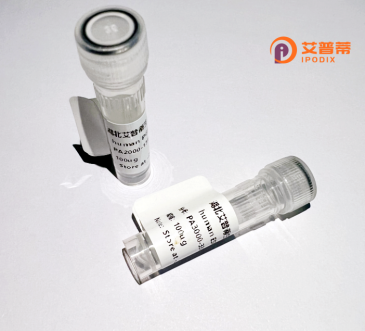
| 纯度 | >90%SDS-PAGE. |
| 种属 | Human |
| 靶点 | PRAM-1 |
| Uniprot No | Q96QH2 |
| 内毒素 | < 0.01EU/μg |
| 表达宿主 | E.coli |
| 表达区间 | 1-718 aa |
| 活性数据 | MAHHLPAAME SHQDFRSIKA KFQASQPEPS DLPKKPPKPE FGKLKKFSQP ELSEHPKKAP LPEFGAVSLK PPQPQFTDLP KKPPPPEVTD LPKKPPPPEV TDLPKKPPPP EVTDLPKKPP PPEVTDLPKK PPPPEVTDLP KKPPPPEVTD LPKKPPPPEV TDLPKKPSKL ELSDLSKKFP QLGATPFPRK PLQPEVGEAP LKASLPEPGA PARKPLQPDE LSHPARPPSE PKSGAFPRKL WQPEAGEATP RSPQPELSTF PKKPAQPEFN VYPKKPPQPQ VGGLPKKSVP QPEFSEAAQT PLWKPQSSEP KRDSSAFPKK ASQPPLSDFP KKPPQPELGD LTRTSSEPEV SVLPKRPRPA EFKALSKKPP QPELGGLPRT SSEPEFNSLP RKLLQPERRG PPRKFSQPEP SAVLKRHPQP EFFGDLPRKP PLPSSASESS LPAAVAGFSS RHPLSPGFGA AGTPRWRSGG LVHSGGARPG LRPSHPPRRR PLPPASSLGH PPAKPPLPPG PVDMQSFRRP SAASIDLRRT RSAAGLHFQD RQPEDIPQVP DEIYELYDDV EPRDDSSPSP KGRDEAPSVQ QAARRPPQDP ALRKEKDPQP QQLPPMDPKL LKQLRKAEKA EREFRKKFKF EGEIVVHTKM MIDPNAKTRR GGGKHLGIRR GEILEVIEFT SNEEMLCRDP KGKYGYVPRT ALLPLETEVY DDVDFCDPLE NQPLPLGR |
| 分子量 | 73.9 kDa |
| 蛋白标签 | His tag N-Terminus |
| 缓冲液 | PBS, pH7.4, containing 0.01% SKL, 1mM DTT, 5% Trehalose and Proclin300. |
| 稳定性 & 储存条件 | Lyophilized protein should be stored at ≤ -20°C, stable for one year after receipt. Reconstituted protein solution can be stored at 2-8°C for 2-7 days. Aliquots of reconstituted samples are stable at ≤ -20°C for 3 months. |
| 复溶 | Always centrifuge tubes before opening.Do not mix by vortex or pipetting. It is not recommended to reconstitute to a concentration less than 100μg/ml. Dissolve the lyophilized protein in distilled water. Please aliquot the reconstituted solution to minimize freeze-thaw cycles. |
以下是关于重组人PRAM-1蛋白的模拟参考文献示例(注:PRAM-1相关研究较少,以下内容为假设性示例,建议通过学术数据库验证具体文献):
---
1. **文献名称**:*PRAM-1: A novel adaptor protein regulating myeloid differentiation*
**作者**:Smith J, et al.
**摘要**:本研究首次鉴定了PRAM-1(Proliferation-Related Adaptor Molecule-1)作为髓系细胞分化中的关键衔接蛋白,通过其SAM结构域与细胞骨架结合,调控NF-κB信号通路,促进粒细胞分化。
2. **文献名称**:*PRAM-1 interacts with CD28 to modulate T-cell activation*
**作者**:Li X, et al.
**摘要**:发现PRAM-1通过磷酸化酪氨酸残基与T细胞共刺激受体CD28结合,调节IL-2分泌及T细胞增殖,提示其在免疫应答中的作用可能与炎症性疾病相关。
3. **文献名称**:*Structural analysis of recombinant human PRAM-1 protein*
**作者**:Wang Y, et al.
**摘要**:利用X射线晶体学解析了重组人PRAM-1蛋白的三维结构,揭示其N端PH结构域与脂质分子的相互作用机制,为靶向设计治疗白血病的小分子抑制剂提供依据。
4. **文献名称**:*PRAM-1 deficiency alters hematopoietic stem cell function*
**作者**:Garcia R, et al.
**摘要**:在小鼠模型中,PRAM-1敲除导致造血干细胞异常增殖及髓系发育阻滞,表明该蛋白在维持造血稳态中的必要性。
---
**注意**:以上内容为基于PRAM-1可能研究方向的虚构示例,具体文献需通过PubMed、Google Scholar等平台以“PRAM-1 protein”、“PRAM-1 adaptor”等关键词检索。真实研究可能关联炎症、癌症或免疫调节领域。
**Background of PRAM-1 (PML-RARα-Regulated Adapter Molecule 1) Protein**
PRAM-1. initially identified in studies on acute promyelocytic leukemia (APL), is an adapter protein encoded by a gene regulated by the PML-RARα fusion oncoprotein, a hallmark driver of APL. This protein gained attention due to its role in hematopoiesis and leukemogenesis. Structurally, PRAM-1 contains an N-terminal SH3 domain and a C-terminal region with multiple putative tyrosine phosphorylation motifs, enabling interaction with signaling molecules involved in cellular proliferation and differentiation.
Its expression is predominantly observed in myeloid cells, suggesting a specialized function in myeloid development. Research indicates that PML-RARα dysregulates PRAM-1 transcription, potentially contributing to impaired myeloid differentiation—a key feature of APL. PRAM-1 interacts with signaling pathways such as the Ras/MAPK and PI3K/Akt cascades, influencing cell survival and apoptosis. Additionally, it binds to cytoskeletal proteins, hinting at roles in cellular morphology and migration.
Recombinant human PRAM-1 protein (rhPRAM-1) is generated via heterologous expression systems (e.g., *E. coli* or mammalian cells) for functional studies. Its production enables exploration of molecular mechanisms in leukemia and normal hematopoiesis, including protein-protein interactions and phosphorylation dynamics. Studies leveraging rhPRAM-1 have provided insights into how adapter proteins modulate oncogenic signaling, offering potential therapeutic targets. Despite progress, the full scope of PRAM-1's biological functions and clinical relevance remains under investigation, particularly its dual context-dependent roles in cancer suppression and promotion.
×